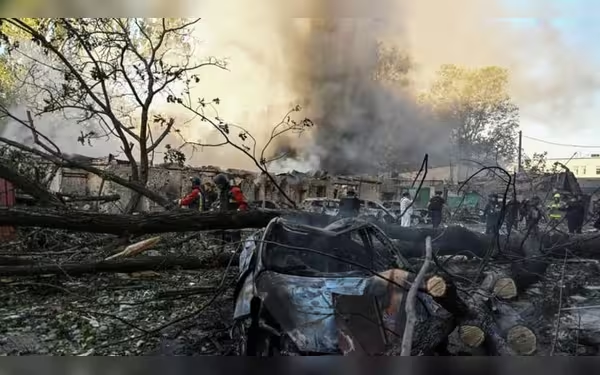Saturday, October 5, 2024 10:47 PM
Ukraine Drone Strike Hits Russian Ammunition Depot
- Ukraine claims successful drone strike on Russian depot.
- Over 100 drones targeted Kotluban military facility.
- Concerns rise over Iran's military support to Russia.
 Image Credits: channelnewsasia
Image Credits: channelnewsasiaUkraine claims a drone strike on a Russian ammunition depot, escalating tensions amid ongoing conflict and concerns over Iranian military support.
In a significant escalation of the ongoing conflict between Ukraine and Russia, Ukraine has claimed responsibility for a drone strike on a major Russian ammunition depot. This incident, which occurred on September 29, 2023, marks a notable increase in Ukraine's military operations deep within Russian territory. The Ukrainian military reported that over 100 drones were deployed to target the Kotluban military depot located in the Volgograd region, far from the Ukrainian border.
The strike was reportedly timed just a day after a shipment of Iranian weapons arrived at the depot, raising concerns about the ongoing military support Iran provides to Russia. According to the Ukrainian military's general staff, "A fire and ammunition detonation were observed on the depot's territory," indicating that the attack was successful in damaging critical military supplies. The facility is known to be involved in the storage and modernization of missiles and artillery, which are vital for Russia's military operations.
While Russia has not officially confirmed the strike, it did report that its air defenses managed to destroy 67 drones overnight in the Volgograd region. A source within the Ukrainian defense sector stated that 120 drones flew over 600 kilometers to reach the target, emphasizing the scale and ambition of this operation. The source further noted, "As a result of the hit, ammunition and missile storage sites were damaged, which will lead to a shortage of ammunition for units of Russia's occupation army." This could potentially impact Russia's military capabilities in the ongoing conflict.
Western governments have accused Iran of supplying drones and missiles to Russia, a claim that Tehran has consistently denied. The situation has raised international concerns about the implications of such military collaborations. Russian military blogger Rybar reported that "several explosions were recorded in the area of Kotluban," but he added that "serious destruction" had been avoided, suggesting that the damage may not be as extensive as initially feared.
Local reports from Volgograd indicated that the drone attack lasted approximately two hours, causing some residents to flee their homes. The governor of Volgograd, Andrei Bocharov, confirmed that while falling debris from the drones sparked grass fires, there were no reported casualties or significant damage to infrastructure.
This drone strike represents the largest Ukrainian drone attack since President Vladimir Putin announced changes to Russia's nuclear doctrine, which now allows for a nuclear response to large-scale cross-border drone attacks. Russian regional governors reported some damage from the attack, with Voronezh Governor Aleksandr Gusev noting that several drones fell on the regional capital, causing fires in residential buildings.
As the conflict continues to evolve, it is clear that both sides are ramping up their military strategies. The use of drones has become a pivotal aspect of modern warfare, allowing for long-range strikes that can significantly alter the dynamics of a conflict. The implications of this drone strike extend beyond immediate military concerns; they highlight the ongoing tensions and the potential for further escalation in the region.
The recent drone strike by Ukraine on a Russian ammunition depot underscores the complexities of the ongoing conflict. As both nations continue to engage in military operations, the international community watches closely, aware that each action taken could lead to broader consequences. Understanding these developments is crucial for grasping the current geopolitical landscape and the potential future of the region.













